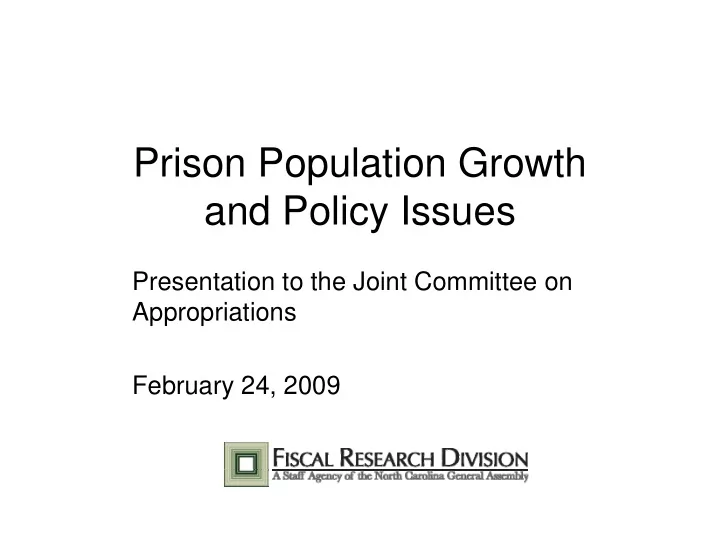

Prison Population Growth and Policy Issues Presentation to the Joint Committee on Appropriations February 24, 2009
Background • The Structured Sentencing Act of 1993 : -Truth in sentencing - Predictability in population - Ability to control population through policy change • The Sentencing and Policy Advisory Commission prepares projections each year forecasting bed needs based on past years’ practices. 2
Based on this year’s ten-year forecast from the Sentencing Commission: The State faces a serious prison bed shortage in the next year, and a huge deficit in the long term. 3
How bad is it? Projections Fiscal Year Projection Expanded Beds over Operating EOC Capacity 2009 40,994 40,014 980 2010 42,296 40,014 2,282 2011 43,165 41,022 1,143 2012 44,024 42,282 1,742 2013 44,987 42,282 2,705 2014 45,998 42,282 3,716 2015 46,937 42,282 4,655 2016 47,882 42,282 5,600 2017 48,823 42,282 6,541 2018 49,770 42,282 7,488
5 8 1 0 2 7 1 0 2 6 EOC How bad is it? 1 0 2 Projections 5 1 0 2 Projection 4 1 0 2 3 1 0 2 2 1 0 2 1 1 0 2 0 1 0 2 9 0 0 2 55000 50000 45000 40000 35000 30000
What can we do? • Utilize more short-term beds • Build more prisons • Adjust criminal justice policies • All of the Above 6
Utilize More Short-Term Beds • GS 148-29 authorizes the Department of Correction to pay counties $40 per day for convicted offenders in jail awaiting transfer to the State prison system, called “jail backlog.” • If the State uses jail beds to meet the projected 2,282-bed deficit in FY 2009-10, it will cost the Department over $90,000 a day. 7
Utilize More Short-Term Beds • The Department does not have a budget for this purpose, and must use funds available, generally lapsed salary, to pay for these beds. • Extended terms in County jails are not ideal for anyone, since counties are not equipped to provide required programs and services including health care. 8
Utilize More Short-Term Beds • In 2007-08, the Department expended $1.8 million for jail backlog; thus far in 2008-09, the Department has spent $2.3 million. 9
Construction and Operating Costs Expanded Operating Capacity Construction Stand-Alone Add-On per Bed - EOC Close Custody $136,500 $89,000 Medium Custody $90,400 $49,600 Minimum Custody $80,250 $63,500 10
Construction and Operating Costs Operating per Daily Annual Bed Close Custody $89.17 $32,569 Medium Custody $79.27 $28,953 Minimum Custody $60.87 $22,233 Average $74.77 $27,310 11
Projected Costs • Based on the projected shortage of 2,705 beds in FY 2013, the State would need to spend over $150 million beginning immediately for construction. • In FY 2013, the cost to operate these 2,705 beds would be $74 million annually . 12
How does the Model work? • The Sentencing Commission prepares projections using a simulation model that looks at two population components: New Convictions and Stock Population. – New admissions to prison over the ten-year period are projected using the most recent fiscal year data. – Existing population declines as inmates are released based on recent time-served data. 13
What can we do? Build more prisons • Based on these projections, the Department of Correction will prepare a ten-year construction plan. • Some components of the plan relate to basic replacement needs as opposed to dealing with future bed deficits, such as hospitals. 14
What can we do? Adjust sentencing policy • Adjust the sentencing grid to reduce average time served in prison • Adjust the sentencing grid to expand the options for judges to use Community and Intermediate punishments instead of prison. • Expand programs with proven records of reducing recidivism. 15
What can we do? Adjust sentencing policy • Adjust B1 through E Felonies: 325 beds saved in five years and 635 in ten years • Sentence Lengths: 224 beds saved in five years and 1,405 in ten years • Restructure Prior Record Points: 485 beds saved in five years and 736 in ten years 16
Adjust B1-E Felonies • Reduce minimum sentence length by three months • Increase maximum sentence length by three months • Increase period of post-release supervision by three months 17
Sentence Lengths (Proportionality) • Change minimum sentence ranges across prior record levels to establish a 15% increment between levels, except for Class H and I felonies, which remain the same 18
Restructure Prior Record Points • Amend the prior record point structure so that the first prior record level, which currently covers offenders with no prior record, could include offenders with one prior record point as well. • If the first prior record level included up to two points, the savings could be 1,334 in five years and 1,992 in ten years. 19
Adjust Sentencing Policy • Other ideas – Amend Habitual Felon statute – Change dispositional options on the grid – Reclassify offenses – Reinstate discretionary release – Other? 20
What can we do? All of the Above • Any new prison construction authorized in 2009 would not be ready for occupancy until 2012, not aiding in the short-term deficits. • Reducing average time served will also take a few years to have a real impact. • Expanding Community and Intermediate options requires resources in the short term. 21
Recommend
More recommend